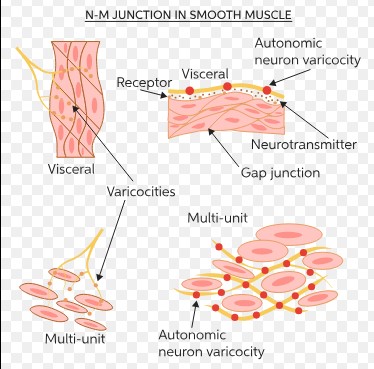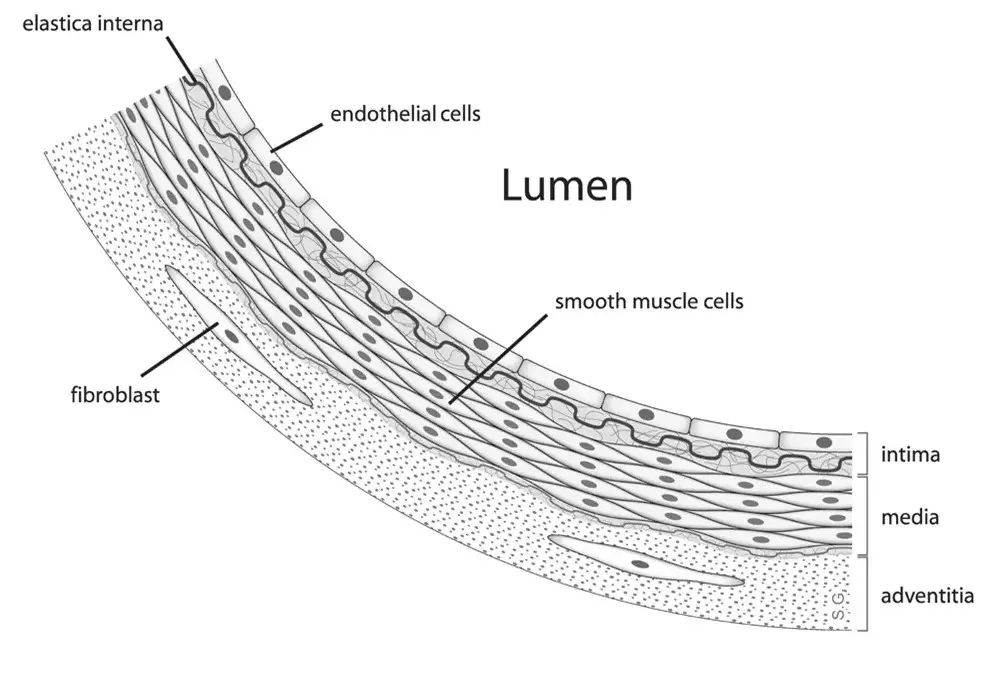Smooth muscle plays a crucial role in the human body, governing a wide range of involuntary movements, from the regulation of blood vessels to the movement of food through the digestive tract. Despite its ubiquitous nature, smooth muscle is not a monolith; it is categorized into two distinct types based on structure, function, and control mechanisms: multiunit and visceral smooth muscle. This differentiation is not merely academic but has profound implications for how organs function and respond to various stimuli.
The difference between multiunit and visceral smooth muscle lies in their cellular arrangement, neural innervation, and how they respond to stimuli. Multiunit smooth muscle fibers operate independently, controlled by individual nerve fibers, making them ideal for fine control and rapid responses, such as in the iris of the eye and the walls of blood vessels. Visceral smooth muscle, on the other hand, functions as a single unit, with fibers connected through gap junctions, leading to synchronized contractions as seen in the gastrointestinal tract and urinary bladder.
Understanding these differences sheds light on the complex orchestration behind bodily functions that are often taken for granted. It also highlights the adaptability of smooth muscle to meet the specific needs of different organs and systems, from the precise adjustment of pupil size in response to light to the coordinated contraction of the gastrointestinal tract during digestion.

Smooth Muscle Overview
Definition and Role
Smooth muscle tissue is a key player in the human body, integral to various involuntary physiological processes. Unlike skeletal muscle, which controls voluntary movement, or cardiac muscle, found exclusively in the heart, smooth muscle is found in the walls of hollow organs and structures such as blood vessels, the gastrointestinal tract, and the bladder. Its primary role is to contract and relax in response to stimuli, facilitating functions like blood flow regulation, digestion, and control of urinary excretion.
Types of Smooth Muscle
There are two main types of smooth muscle: multiunit and visceral. These classifications are based on the muscle fibers’ structural organization, neural innervation, and how they respond to stimuli. Understanding these types is crucial for grasping how different organs function and interact within the body.
Multiunit Smooth Muscle
Characteristics
Multiunit smooth muscle is defined by its individual muscle fibers, which operate independently of each other. Each fiber is innervated by its own nerve ending, allowing for precise control. This type of smooth muscle does not typically contract as a single unit but rather in a fine-tuned, localized manner.
Locations and Examples
Multiunit smooth muscle is found in locations requiring fine control and rapid responses. Notable examples include:
- The iris of the eye, adjusting the pupil size to regulate the amount of light entering the eye.
- The ciliary muscles of the eye, which focus the lens to facilitate clear vision.
- The walls of large blood vessels, controlling vasoconstriction and vasodilation to regulate blood pressure and flow.
Function and Regulation
The functioning of multiunit smooth muscle is highly dependent on neural input from the autonomic nervous system. The unique structure allows for:
- Selective contraction, where only specific muscle fibers contract in response to stimulation.
- Rapid adjustment to stimuli, essential for processes like pupil dilation and blood vessel regulation.
This type is primarily regulated by neurotransmitters released from nerve endings directly onto the muscle fibers, leading to a precise and localized response.
Visceral Smooth Muscle
Characteristics
In contrast, visceral smooth muscle fibers are not individualized but connected to one another via gap junctions. This connectivity allows the muscle to contract as a single unit, promoting coordinated contractions across the organ. Visceral smooth muscle is noted for its rhythmicity and ability to sustain long contractions, essential for processes such as peristalsis in the digestive system.
Locations and Examples
Visceral smooth muscle is predominant in:
- The gastrointestinal tract, moving food along through peristalsis.
- The uterus, contracting during childbirth.
- The bladder, controlling urination through coordinated contractions.
These locations highlight the muscle’s role in continuous, coordinated processes rather than rapid, fine-tuned actions.
Function and Regulation
The function and regulation of visceral smooth muscle are distinct due to its structure and the nature of its tasks. Its operation involves:
- Spontaneous electrical activity in the muscle fibers, leading to rhythmic contractions.
- Regulation by both the autonomic nervous system and hormones, which can modulate the frequency and strength of contractions.
Key Differences
Understanding the key differences between multiunit and visceral smooth muscle illuminates the complexity and elegance of the body’s internal mechanisms. Each type of smooth muscle plays a pivotal role, finely tuned to the requirements of the organs they inhabit.
Cellular Structure
The cellular structure is a fundamental difference between multiunit and visceral smooth muscle. Multiunit smooth muscle fibers are individualized, each with its own nerve supply, allowing for precise control. In contrast, visceral smooth muscle fibers are interconnected through gap junctions, facilitating synchronized contractions across the muscle mass.
Neural Innervation
Neural innervation also varies significantly. Multiunit smooth muscle receives direct innervation from the autonomic nervous system, with neurotransmitters released onto specific muscle fibers, allowing for targeted activation. Visceral smooth muscle, however, often operates through intrinsic electrical activity and is modulated rather than directly controlled by neural inputs, responding to broader signals from the autonomic nervous system and hormonal influences.
Response to Stimuli
The response to stimuli further distinguishes these muscles. Multiunit smooth muscle’s independent fibers can respond rapidly and selectively, making it ideal for quick adjustments like the dilation of the pupil. Visceral smooth muscle, with its rhythmic contractions, is more about sustained, coordinated efforts, such as moving food through the digestive tract or emptying the bladder.
Functional Roles
Their functional roles highlight their specialization. Multiunit smooth muscle’s precision supports functions requiring fine control, like focusing the eye. Visceral smooth muscle’s coordinated contractions are crucial for processes that require sustained, rhythmic action, such as peristalsis in the gastrointestinal tract.
Physiological Implications
The differences between multiunit and visceral smooth muscle have profound physiological implications, affecting everything from the efficiency of organ function to the body’s response to disease.
Impact on Organ Function
The impact on organ function is significant. Multiunit smooth muscle ensures organs like the eye and blood vessels can quickly adapt to changing conditions. Visceral smooth muscle’s ability to generate sustained contractions is essential for the continuous operation of the gastrointestinal system, urinary system, and during childbirth.
Disease and Disorders
Understanding these muscles also sheds light on diseases and disorders. Dysfunction in multiunit smooth muscle can lead to conditions like hypertension, if blood vessels cannot properly dilate, or asthma, if airways are overly constricted. Problems in visceral smooth muscle may result in disorders like irritable bowel syndrome, where coordinated contractions are disrupted, leading to symptoms such as cramping and abnormal bowel movements.
Research and Developments
Recent Studies
Recent studies have focused on understanding the molecular mechanisms that regulate smooth muscle behavior. Research has explored how alterations in the expression of proteins involved in contraction and relaxation can influence diseases such as asthma, hypertension, and gastrointestinal disorders. For example, studies have identified specific genetic markers that can predispose individuals to these conditions, offering potential targets for new treatments.
Future Directions
The future directions of research into smooth muscle are promising, with several areas poised for breakthroughs. One area is the development of drugs that can specifically target the regulatory mechanisms of smooth muscle, offering more precise treatments with fewer side effects. Another exciting avenue is the potential for regenerative medicine to repair or replace damaged smooth muscle tissue, especially in organs like the heart and gastrointestinal tract.
Frequently Asked Questions
What is Smooth Muscle?
Smooth muscle is a type of muscle tissue found throughout the body, responsible for involuntary movements. It differs from skeletal and cardiac muscle in structure and function, enabling a wide range of bodily functions, including regulating blood flow, controlling bladder contractions, and moving food through the digestive system.
How Does Multiunit Smooth Muscle Function?
Multiunit smooth muscle functions through the independent contraction of its fibers, each controlled by individual nerve fibers. This arrangement allows for precise control and rapid responses, making it critical for functions requiring fine adjustments, such as controlling pupil size and focusing the lens in the eye.
What Role Does Visceral Smooth Muscle Play in the Body?
Visceral smooth muscle plays a key role in moving substances through internal organs. Its fibers are interconnected, allowing for synchronized contractions that propel food through the digestive tract, aid in childbirth, and control the elimination of waste through the urinary bladder and intestines.
How Are Multiunit and Visceral Smooth Muscles Regulated?
Multiunit smooth muscle is primarily regulated by the autonomic nervous system through individual synaptic connections, allowing for targeted responses. Visceral smooth muscle, however, is regulated by a combination of the autonomic nervous system and various hormones, which coordinate widespread, rhythmic contractions across interconnected muscle fibers.
Conclusion
The distinction between multiunit and visceral smooth muscle illuminates the nuanced mechanisms that enable the body to perform a myriad of involuntary actions seamlessly. Understanding these differences not only offers insight into basic physiological processes but also underscores the complexity and efficiency of the body’s internal systems. It reveals the remarkable adaptability of smooth muscle tissues, tailored to meet the specific demands of different organs and functions.
By appreciating the unique characteristics and roles of multiunit and visceral smooth muscles, we gain a deeper understanding of human physiology. This knowledge not only enriches our comprehension of bodily functions but also has potential implications for medical science, offering pathways for targeted therapies and interventions in treating diseases affecting smooth muscle function.

